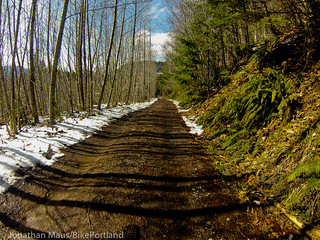
(Photos © J. Maus/BikePortland)
The Oregon Department of Transportation (ODOT) knows that if Mt. Hood is to remain a popular recreation destination there’s got to be a better way to get up there than driving in a car. Highways that connect to Mt. Hood are becoming magnets for congestion and crashes, so the agency has launched the Mt. Hood Mutlimodal Transportation Plan, a project they’re working on in partnership with the US Forest Service, the Federal Highway Administration, and Hood River and Clackamas Counties.
The impetus for this project (which includes Mt. Hood, Sandy, and Hood River) is the federal Omnibus Public Land Management Act of 2009. Section 1207 of that law, under the heading “Tribal provisions, planning and studies” says that ODOT must develop, “an integrated, multimodal transportation plan for the Mount Hood region to achieve comprehensive solutions to transportation challenges.” Among those challenges, says ODOT Region 1 Project Planner Mike Mason is ever-increasing traffic and a history of crashes.
“There’s a lot of demand and interest in biking both on Highway 35 and 26.”
— Mike Mason, ODOT Region 1
Traffic to Mt. Hood is only expected to increase from the 2-5 million annual visitors it already gets and one huge growth area is bicycling. Mt. Hood is home to a hut-to-hut mountain biking system, popular singletrack trails, a growing number of mountain bike races and events, the Sandy Ridge trail system, the mountain bike park at Skibowl, and the Timberline MTB Bike Park which is expected to be open for business in summer 2014. Other bicycling trends around Mt. Hood are unsanctioned road races and fatbiking on snowmobile and cross-country ski trials.
“In the winter and summer months, there is a tremendous number of people who go up to the mountain for recreations,” said Mason during a phone call earlier this week, “During peak periods it’s really congested and dangerous. There are a lot of crashes.” Separate from this planning project, ODOT is already pumping $27 million dollars into “safety and preservation” projects like their U.S. 26 Mt. Hood Highway Safety Project.
While the Highway 26 project is aimed at making driving safer, Mason says the goal of their Multimodal Transportation Plan is to encourage fewer people to hop in a car to begin with. “What we’re hoping to find are good ideas to reduce the number of people who feel they need to drive cars up there.” He’s also aware that much of the Mt. Hood traffic comes from young people who may not even drive yet. “How are they going to up there?” he wonders.
Due primarily to environmental constraints, Mason made it clear that expanding highway capacity for auto traffic is not on the table. “Widening the corridor is not going to happen,” he said. “This isn’t a typical ODOT highway planning project.”
“Are people interested in increased transit between Gresham and Sandy?” Mason asked rhetorically,”Does it make sense to have a park-and-ride and jump on a bus? What types of ways can we get fewer people driving up but still get them to the ski hills?” (It’s worth noting that The Mt. Hood Forest and Clackamas County were just awarded a transit grant for the “Mountain Express” bus service a few weeks ago.)
Mason spoke a lot about bicycling and access to existing bike trails. “We hear a lot from Hood River about people biking. There’s a lot of demand and interest in biking both on Highway 35 and 26.”
The budget for this plan is $300,000 for outreach and planning and $350,000 for implementation (paid with funds from all project partners). With the implementations funds, ODOT says they could end up doing things like lane striping changes, improving the condition of roadway shoulders, improving access to trailheads, changing curb alignments, and so on. “This plan isn’t meant to include everything,” is how Mason put it, “What we’re aiming to do is come up with some affordable projects that can be implemented in the near term.”
This will be a very interesting plan to follow and involvement from people who bike on, to, or around Mt. Hood will be crucial. ODOT needs and wants to hear from you and they plan to have a “manageable list” or actions by this summer and implement them by the end of the year. Stay tuned for a survey and other options to share your input in the next few months.
Learn more at the official ODOT project page.


